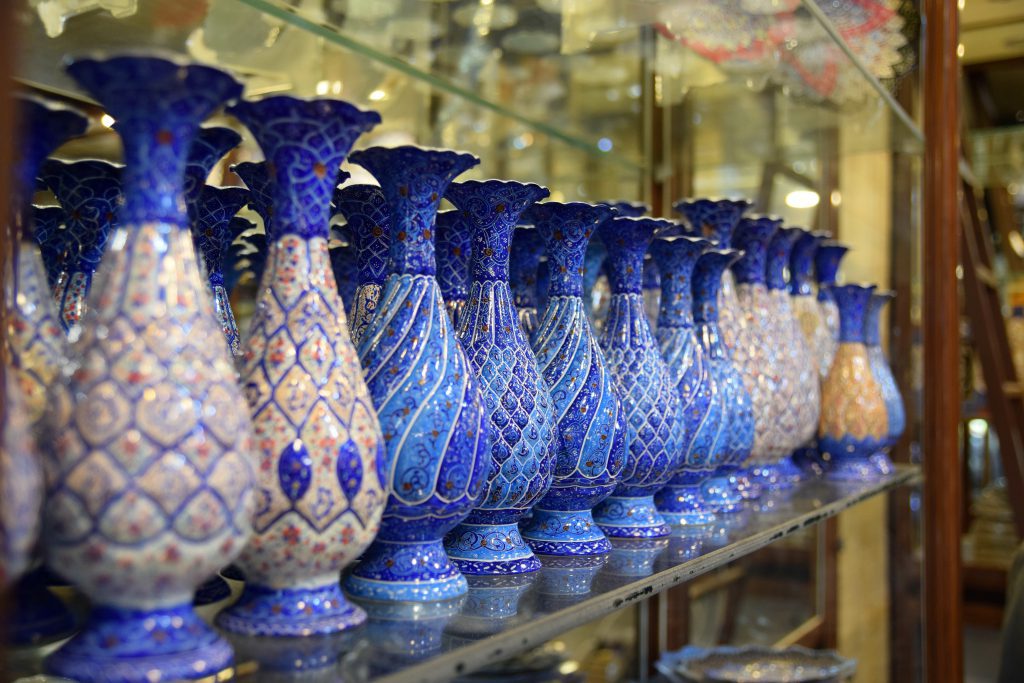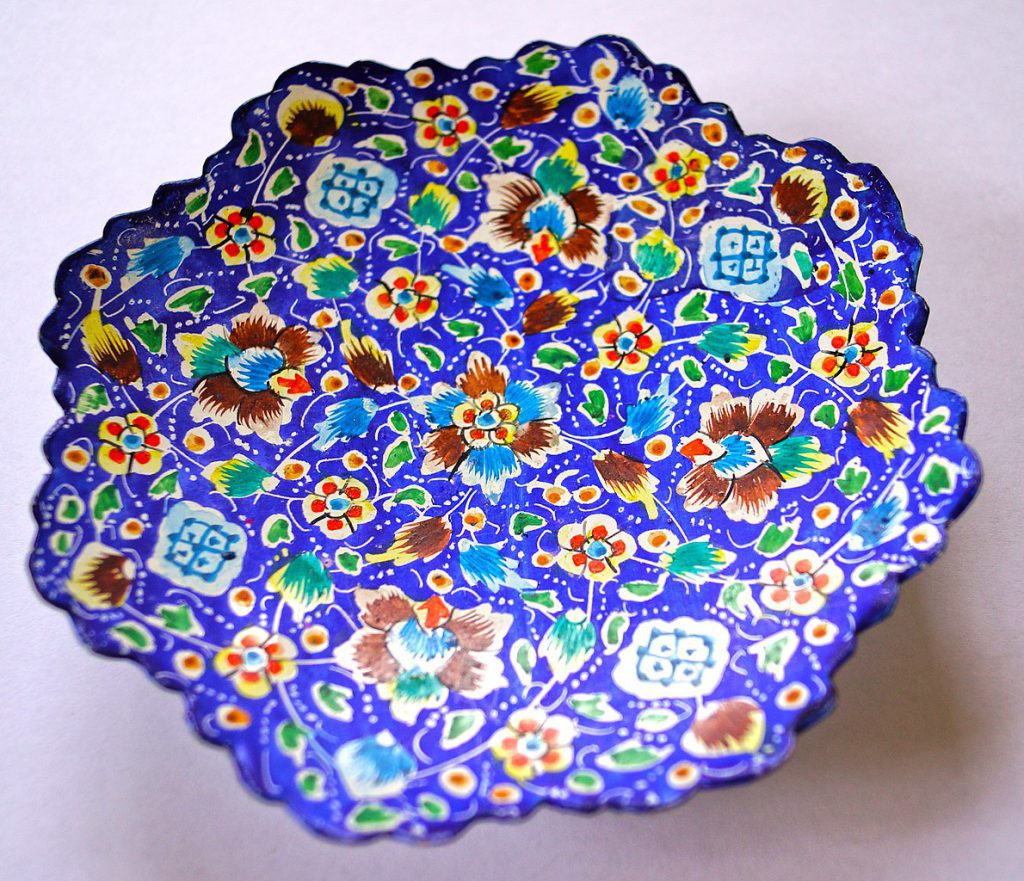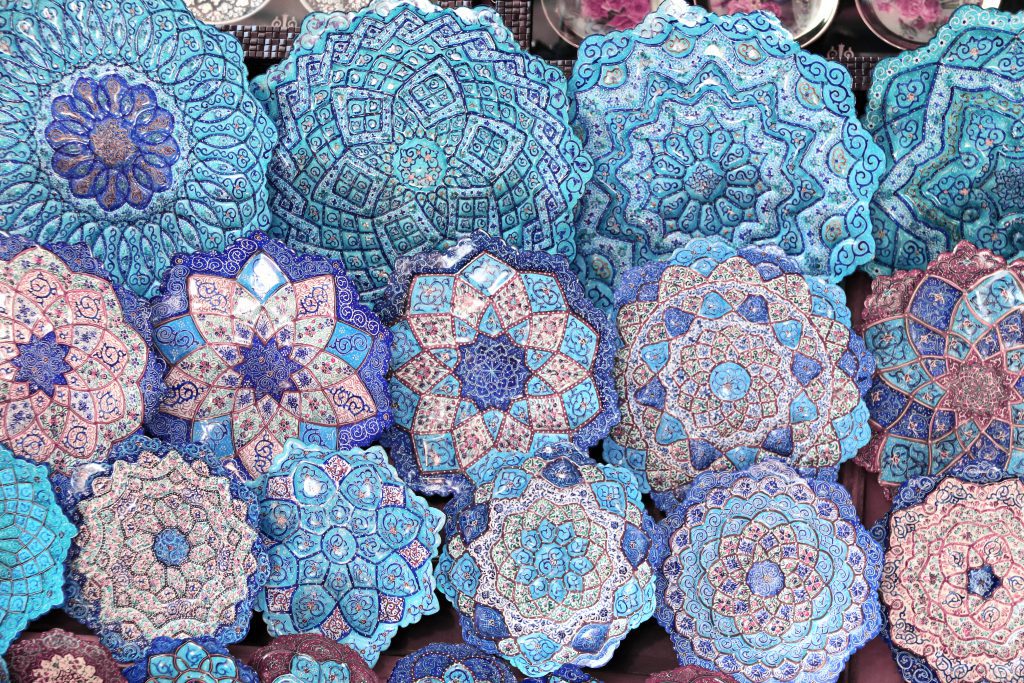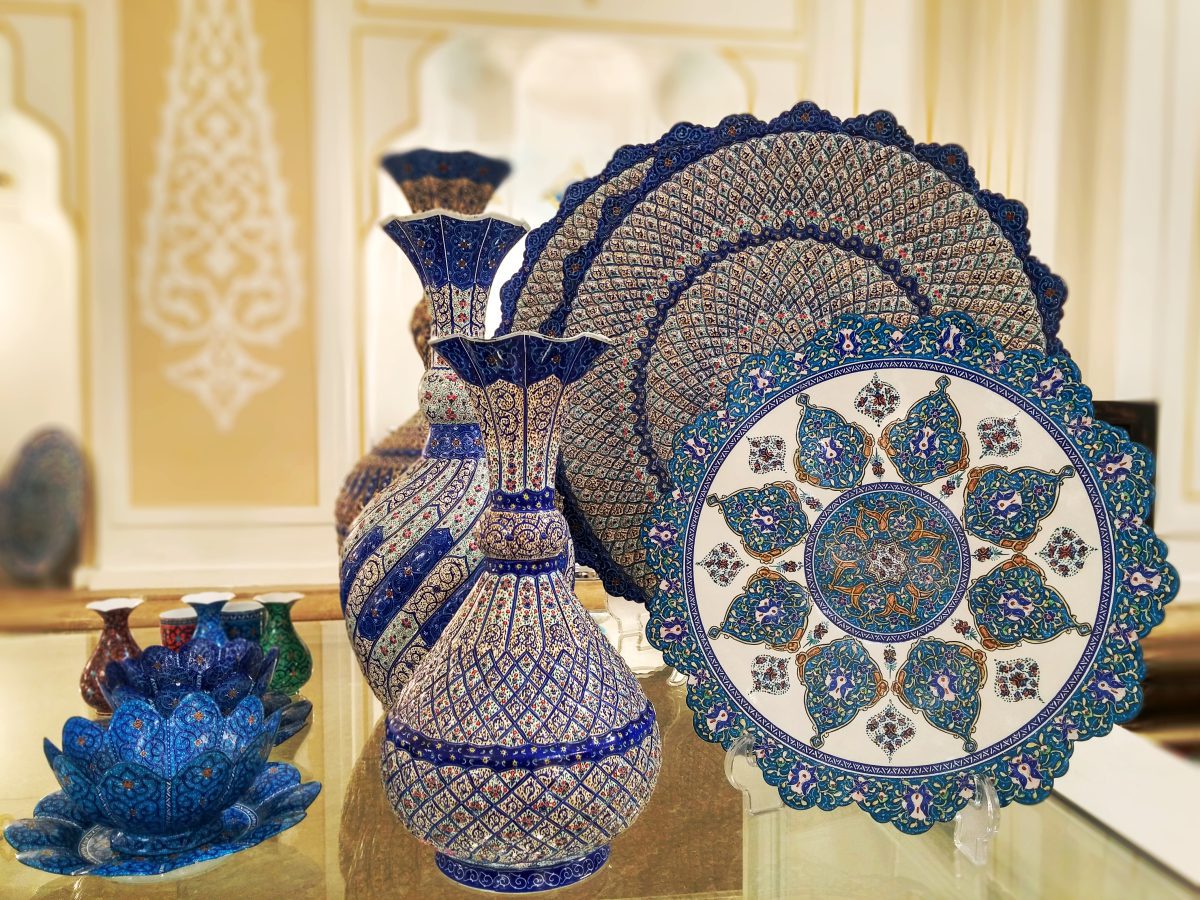Table of Contents
Minakari, also known as enameling, is often referred to as the “miniature of fire.” It involves the delicate process of adorning metals and tiles with a special Mina glaze, transforming them into vibrant works of art. This ancient craft brings together the fiery interaction between glaze and surface, resulting in a colorful, glass-like finish that is both luminous and long-lasting.
The art of Minakari encompasses painting, coloring, and intricate ornamentation. Craftsmen skillfully fuse radiant pigments onto metal surfaces, creating stunning designs that are both detailed and bold. Each piece becomes a brilliant display of colors, formed with a precision that reflects centuries of expertise and tradition.
History of Minakari

Dating back to around 1500 BC, Minakari is a captivating form of Persian enameling that has left an indelible mark on the world of handicrafts. While its roots are firmly planted in Persia, the influence of this exquisite art form can be seen in various cultures globally. The Seljuk era, particularly in the 11th century, is often regarded as the zenith of Minakari in Iran, showcasing intricate designs that reflected the artistic spirit of the time. Yet, the evolution of this craft did not cease there; it absorbed influences from the Timurid period, where the aesthetics of Eastern and Mongol arts began to blend seamlessly into its creations.
As time progressed, the Safavid era introduced fresh motifs, including dynamic hunting scenes, further enriching the repertoire of Minakari. The Qajar period marked a significant expansion of this art, as artisans began adorning a wider array of objects—from pots to earrings—transforming everyday items into stunning works of art. This rich tradition has not only persisted into the Pahlavi era but continues to thrive today, with contemporary Iranian artists breathing new life into Minakari, ensuring that its legacy endures for future generations.
The Spread of Minakari
The origins of Minakari can be traced back to the innovative craftsmen of the Sasanian era, who first breathed life into this exquisite art form. From Persia, the Mongols played a pivotal role in disseminating this craft, carrying its vibrant colors and intricate designs across borders into India and beyond. This cultural exchange not only enriched this Persian craft but also allowed it to adapt and flourish in new environments, making its mark on diverse artistic traditions.
During the Safavid period, the allure of Minakari caught the attention of travelers, including the French explorer Jean Chardin. His observations of enamel work from Isfahan described stunning patterns featuring birds and animals set against a backdrop of floral motifs, all rendered in a captivating palette of light blue, green, yellow, and red. Chardin’s accounts served as a testament to Minakari’s beauty and complexity, further solidifying its reputation as a cherished art form that transcended geographical boundaries and resonated with connoisseurs around the world.
Etymology of Minakari
At the heart of the term “Minakari” lies the word “Mina,” a feminine variant of “Minoo,” which translates to “heaven” in Persian. This connection evokes a sense of celestial beauty, as “Mina” also symbolizes the deep azure of the sky. The enchanting hue reflects not only the artistry involved in this craft but also its ethereal qualities, inviting viewers to experience a glimpse of the heavenly.
This profound association with the sky amplifies the allure of Minakari, as artisans strive to encapsulate the divine essence within their creations. The intricate designs and vibrant colors echo the serenity and splendor of the heavens, transforming ordinary objects into miniature masterpieces that resonate with a sense of the sublime. In this way, Minakari transcends mere decoration; it becomes a celebration of the beauty found both in art and in the cosmos above.
Designs and Patterns of Minakari

The realm of Minakari is rich with a tapestry of designs that evoke the essence of paradise itself. The enchanting floral motifs and bird patterns found within this art form serve as reminders of a celestial world, inviting beholders to lose themselves in the beauty of nature. Alongside these organic shapes, one can also discover arabesque and symmetrical patterns, which add a layer of complexity and harmony to each piece. Each design is thoughtfully crafted, aiming to reflect the divine and the transcendent.
In Iran, various styles of Meenakari painting and design showcase the diversity of this ancient craft:
One notable type is Barjast-e Mina, which features embossed engravings filled with vibrant glazes, creating a striking three-dimensional effect.
Another rarity is Khaneh Bandi, characterized by its chess-like patterns that challenge traditional aesthetics.
Perhaps the most celebrated style is Mina Naghashi, particularly popular in Isfahan, where artisans skillfully paint intricate scenes that bring the surface to life.
Together, these designs not only highlight the technical prowess of the craftsmen but also weave a narrative that connects art to the heavenly beyond.
Making Process of Minakari

- Shaping and Bending: The process begins with the careful shaping and bending of copperware to create the desired form for the artwork.
- Cleaning: The copper object is meticulously cleaned to prepare it for the glazing process, ensuring proper adhesion.
- Preparing the Glaze: A white glaze is prepared, which will serve as the foundational layer for the painting.
- First Firing: The object is placed in a furnace to fire the initial glaze, creating a smooth and durable surface.
- Preparing the Paint: Artisans mix vibrant paints, often incorporating industrial colors with gold to enhance the artwork’s value.
- Painting: Skilled artists carefully apply the prepared paints onto the glazed surface, using intricate patterns inspired by traditional Persian designs.
- Second Firing: After painting, the piece is fired in the furnace again to set the colors and deepen their vibrancy.
- Coating with Glaze: A thin layer of glaze is applied over the painted surface to protect and enhance its beauty.
- Third Firing: The object undergoes another firing in the furnace to finalize the glazing process and ensure durability.
- Final Touches: The piece may be subjected to one last firing, solidifying its colors and details while completing the Meenakari art.
Where to Buy Minakari Works
In Isfahan, the heart of Persian handicrafts, two prominent bazaars stand out for their vibrant offerings of Minakari art: the Qeysarieh Bazaar and Hassan Abad Bazaar.
The Qeysarieh Bazaar, steeped in history, is a bustling hub where visitors can explore a myriad of shops showcasing exquisite enamelware, from intricately painted vases to decorative plates.
Just a stone’s throw away, Hassan Abad Bazaar complements this experience with its own unique selection of artisanal crafts. As you wander through these lively markets, the rich colors and delicate patterns of Meenakari art pieces beckon, inviting you to discover the artistry that has been passed down through generations.
Essential Tips to Know
When purchasing Minakari works, it’s essential to ensure authenticity and quality. Look for the artist’s signature on each piece as a mark of genuine craftsmanship. Additionally, inspect the surface for cleanliness and evaluate the evenness of color thickness; these factors are crucial indicators of a high-quality item. Whether you’re seeking a stunning addition to your home decor or a meaningful gift that will last a lifetime, the treasures found in Isfahan’s bazaars promise to encapsulate the beauty and heritage of Persian art.
FAQs about Minakari
Q1: What is Minakari in English?
A1: Minakari, or Meenakari, is the technique of painting and coloring metal surfaces and ceramic tiles using enamel. It began in Safavid Iran.
Q2: What is the history of Minakari art?
A2: The history of Meenakari jewelry is an interesting story that goes back to the Mughal era, around the 16th century. During this time, Mughal emperors, especially Akbar, strongly supported this art. Meenakari jewelry adorned royal courts, representing wealth and grandeur.
Q3: What is the process of Minakari?
A3: The Meenakari process includes several steps. First, the metal surface is cleaned, and then the design is engraved on it. Next, the cavities from the design are filled with enamel paste. Finally, the piece is fired in a kiln so the enamel can bond with the metal.
Q4: What material is used in Meenakari?
A4: A range of metals is used for Meenakari designs, including brass, copper, silver, and gold. The enamel colors mainly consist of metal oxides mixed with a bit of finely powdered glass.
Q5: What is the difference between Kundan and Meenakari?
A5: While Kundan work highlights the beauty of stones and gold, Meenakari work focuses on vibrant colors and detailed enamel designs.
Last Words: Discover the Best of Minakari Works with a Customized Tour
Minakari, or enameling, is an art form that decorates metals and tiles with a special glaze, making them bright and colorful. This ancient craft combines heat and glaze to create a shiny, glass-like finish that lasts a long time. In Minakari, artists paint and decorate with vibrant colors, carefully applying pigments to create beautiful and detailed designs. Each piece showcases a mix of colors, reflecting years of skill and tradition.
If you’re eager to explore the vibrant world of Minakari, the best way to experience it is through a Customized tour of Iran. To make your journey unforgettable, consider To Iran Tour. We specialize in offering professional Iran tours and travel packages designed to meet your unique preferences. Whether you want to visit local artisans, explore historical sites, or enjoy the stunning landscapes, we work with you to create the perfect travel plan. Our team is dedicated to helping you have a remarkable experience in Iran, ensuring you connect deeply with the artistry of Minakari and the warmth of Iranian hospitality.
Explore the beauty of Iran Tours with us and create memories that will last a lifetime!

